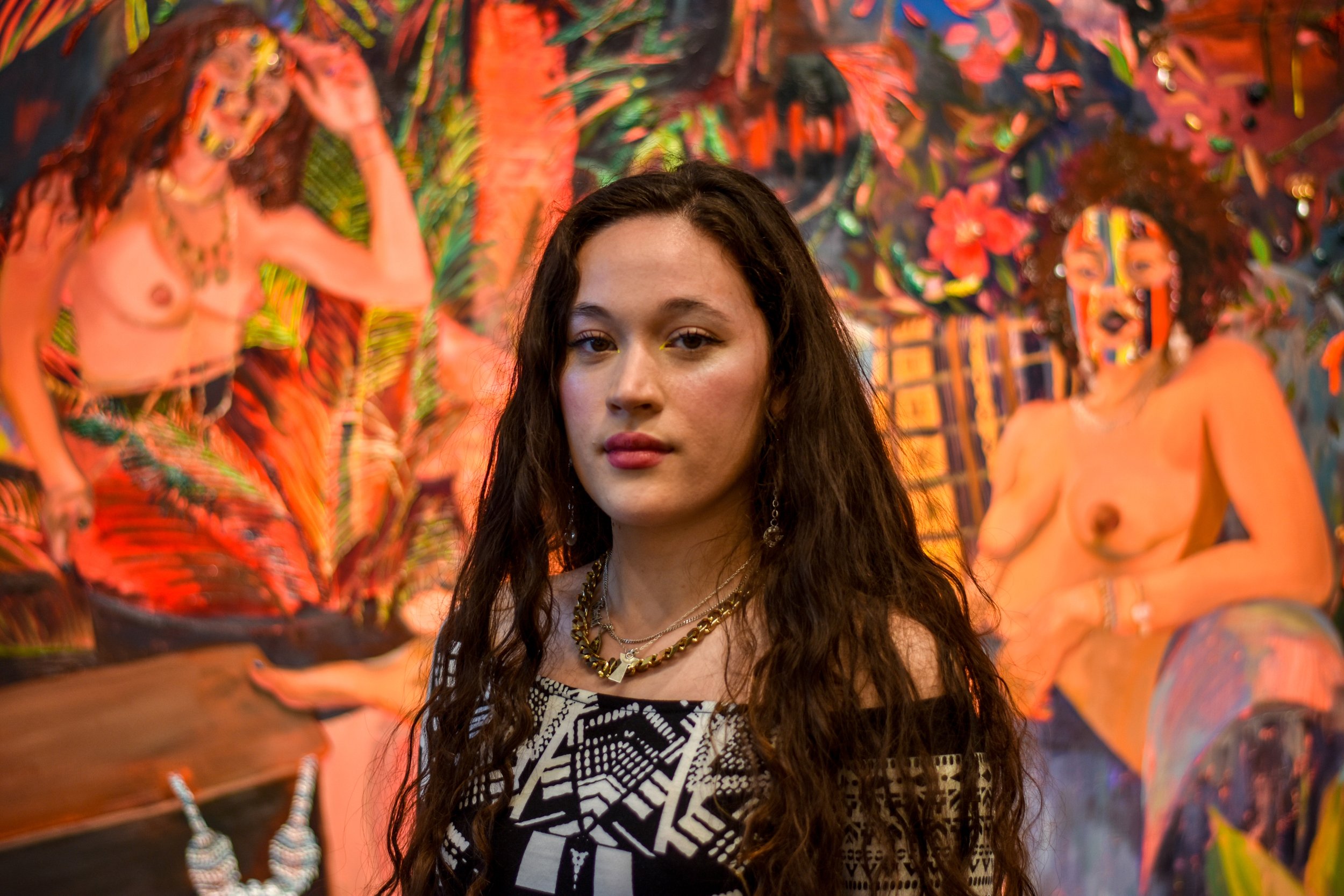Celebrating Women Artists
Gisela McDaniel, Rachel Stern and Rashayla Marie Brown
Joining us in March 2022, Gisela, Rachel and Rashayla are part of Fountainhead Residency's inaugural Celebrating Women Artists residency. The residency is focused around their shared experience as female artists working within the contemporary art world. Their residency is generously sponsored by the Carlo and Micol Schejola Foundation.
Gisela McDaniel
Gisela McDaniel’s work arises out of the community she’s built upon their shared trauma, and reclaims the narrative around sexual violence to empower and celebrate her subjects’ strength. Her large scale, often interactive paintings of women - usually friends, family, or women within her orbit - are created in collaboration with her subjects; they work in tandem with Gisela to pose themselves, and to choose the setting, objects, and colors foregrounding their image. According to Gisela, the painting becomes a visual telling of her subjects’ stories, and an opportunity for the viewer to acknowledge how they take up space. She intentionally works on canvases that are at least 6 inches thick, an allusion to the space she wants to hold for the women she paints. In some instances, Gisela uses motion sensor technology to bring the painting to life when a viewer walks past it.
Her process involves bringing her subjects in for a conversation, where they discuss which objects are important to them and how they would pose, creating an aura of identity around them. Giving her subjects this level of autonomy allows them to control how their image is perceived. Taking a photo of their design, Gisela uses the photograph to guide her painting, Gisela hints at who they truly are, and who they want to be. Gisela is represented by Pilar Corrias gallery in London, has work in the permanent collection of the Perez Art Museum Miami, and was recently featured in Hyperallergic and Artnet.
Rachel Stern
Rachel Stern draws parallels between the illusion of photography and the paradox of kitsch, an aesthetic quality she defines as striving for something that is otherwise inaccessible. She explores a kind of ‘trickle-down aesthetic history' to better understand why particular icons of art history are mass-produced into everyday objects and embody certain cultural meanings. While her work usually takes shape in installation, sculpture, and other media, Rachel initially builds everything through the lens of the camera, imagining the worlds she constructs in her studio as being moments in time rather than perceptible truths.
With a formal training in photography, her works often begins with a reference from literature or pop culture, which she elaborates by photographing friends, family, or colleagues characterized through allegorical portraits. Drawing from the everyday objects that litter her studio—crafts, knick-knacks, and other quotidian trappings—Rachel builds onto and around the photograph itself, creating a subtle yet accessible inside joke for her viewers. Deploying objects that permeate our everyday life to create aesthetic beauty as a work of art, she relies on the camera’s ability to record the familiar but make it strange, Her photography and the world it both creates and inhabits reflects on the trappings of capitalism, reframing critical discourse around consumerism. An adjunct assistant professor of photography, Rachel’s work is in the collection of the Philadelphia Museum of Art and the MoMA Library, and has been featured in the New York Times and Hyperallergic.
Rashayla Marie Brown
Rashayla Marie Brown is an “undisciplinary” artist, rejecting the formality of institutional artmaking in favor of a practice that questions the hierarchies these labels allow to persist. Working principally in performance, installation, writing, filmmaking and photography, RMB’s work uncovers the erasure of Black femme history, utilizing bold colors, domestic and spiritual references, and staged images of friends and family in her work. Drawing from a background as a DJ, graphic designer and spoken word artist, her work parallels these art forms, favored for their accessibility and ability to make an impact among a wide audience. Using these mediums allows RMB to consider what photo and films can often tend to exclude or omit from historical narratives; her childhood upbringing in Germany informs much of the way she considers selfhood, filtered through a new reality once she returned to the United States.
Working both collaboratively and intuitively, and drawing from her own spiritual work and experience, RMB’s process often begins with a conversation. These words form the basis of her research, marking the starting line of inquiry from which she will build out the work’s chosen materials and form. Rooted in social justice, RMB’s works question power dynamics within race, religion, gender, sexuality, and mental health constructs; she believes artists need to stand in direct opposition to harmful institutions. She is currently pursuing her Ph.D. in Performance Studies at Northwestern University in collaboration with the Isaac Julien Lab at UC-Santa Cruz and most recently exhibited with the Museum of Contemporary Art Chicago.













